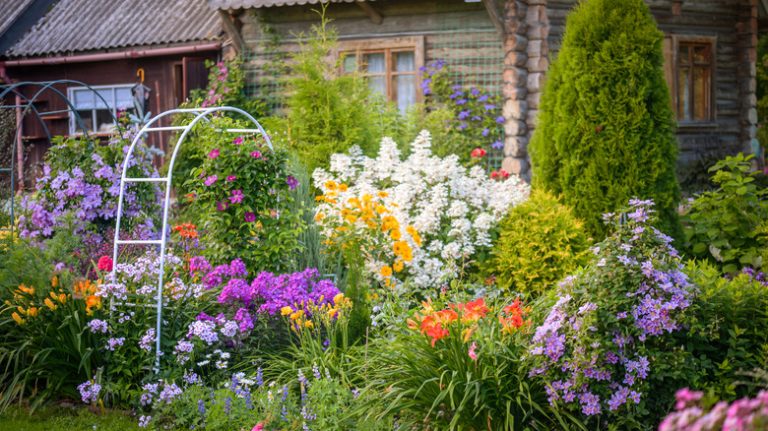Fuchsias are beautiful flowering plants that can add a pop of color to any garden or outdoor space. Whether you are a seasoned gardener or just starting out, fuchsias are a great choice because they are relatively easy to care for and can thrive in a variety of conditions. In this article, we will share seven tips for growing fuchsias in hanging baskets, ensuring that these stunning plants reach their full potential.
The first thing to consider when growing fuchsias in hanging baskets is the spot where you will place the basket. Fuchsias love sunlight but can be damaged by frost, so it’s important to find a sheltered spot that receives plenty of sunlight but is also protected from any potential frost. A south or west-facing spot is usually best for these plants.
When planting your fuchsias, it’s important to use a free-draining and moisture-retentive soil medium. Fuchsias do not like waterlogged soil, so adding a layer of gravel at the bottom of the basket or using a line of small containers at the bottom can help improve drainage. This will ensure that the roots of the fuchsia plants stay healthy and happy.
In terms of watering, fuchsias require regular watering, especially during hot summer months. However, it’s important not to overwater them, as this can lead to root rot. The best way to water fuchsias in hanging baskets is to water them thoroughly until the water starts draining out of the bottom of the basket. You can also place a tray under the basket to catch any excess water.
Deadheading is another important aspect of caring for fuchsias in hanging baskets. Deadheading refers to removing the faded or dead flowers from the plant. This not only keeps the plant looking neat and tidy, but it also encourages new blooms to grow. Simply pinch off the faded flowers, making sure to remove them along with their stems.
Fuchsias can be prone to pests, such as aphids or whiteflies. To keep these pests at bay, you can spray the plants with an eco-friendly insecticide or introduce beneficial insects, such as ladybugs or lacewings, into your garden. Regularly checking the leaves and stems for any signs of pests will help you detect and resolve any issues before they become a major problem.
Fertilizing your fuchsias is also important for their growth and blooming. You can use a balanced liquid fertilizer every two weeks during the growing season, following the instructions on the packaging. This will provide the necessary nutrients for the plants to thrive and produce beautiful flowers. Remember to follow the recommended dosage and avoid overfeeding the plants.
Finally, fuchsias in hanging baskets will need some protection during the winter months. If you live in an area with freezing temperatures, it’s best to bring the baskets indoors and place them in a cool, dark room. You can also prune the plants back by about half to help them conserve energy. Make sure to water them sparingly during this period, as the plants will be in a dormant state.
By following these seven tips, you can successfully grow fuchsias in hanging baskets and enjoy their stunning blooms all summer long. Fuchsias are versatile plants that can thrive in different conditions, so whether you are a beginner or an experienced gardener, these tips will help you keep your fuchsias healthy and beautiful.
How to care for a fuchsia hanging basket
Caring for a fuchsia hanging basket is not a complicated task, but it does require some attention and care to keep your fuchsias healthy and blooming. Here are some tips to help you maintain your fuchsia hanging basket:
- Choose the right spot: Place your fuchsia hanging basket in a spot where it can receive bright, indirect sunlight. Fuchsias grow best in partial shade, so avoid placing them in direct sunlight.
- Keep the soil moist: Fuchsias prefer moist soil, so make sure to water your hanging basket regularly. However, be careful not to overwater as this can lead to root rot. Check the soil moisture regularly and water when the top inch feels dry.
- Provide good drainage: Use a hanging basket with drainage holes or line the bottom with rocks or broken clay pots. This will prevent water from accumulating and ensure that the roots do not become waterlogged.
- Feed your fuchsias: Fuchsias are heavy feeders and will benefit from regular feeding. Use a balanced liquid fertilizer every two weeks during the growing season to promote healthy growth and abundant flowering.
- Deadhead spent flowers: Remove faded or wilted flowers to encourage continuous blooming. Pinch off the dead flower heads to promote the growth of new flowers.
- Protect from pests: Fuchsias can be susceptible to aphids and other pests. Regularly check for any signs of infestation and treat accordingly. You can use organic pest control methods or insecticidal soap to keep these pests at bay.
- Overwintering: In colder regions, fuchsias are not winter hardy and need to be protected during the winter months. Before the first frost, bring your hanging basket indoors and place it in a cool, frost-free room with bright, indirect light. Water sparingly during this period and prune back any leggy growth in early spring.
By following these tips, your fuchsia hanging basket will stay healthy and provide you with beautiful blooms throughout the growing season. Enjoy the vibrant colors and graceful habit of these lovely plants!
Find the perfect spot for your fuchsia hanging basket
When it comes to growing fuchsias in hanging baskets, finding the right spot is essential for their success. Fuchsias are known for their love of sunlight, but they also need some protection from the elements. Here are some tips to help you find the perfect spot for your fuchsia hanging basket:
| Tip 1: | Choose a spot that receives at least half a day of sunlight. Fuchsias thrive in bright, indirect light, so a west-facing window or a spot with morning sun and afternoon shade is ideal. |
| Tip 2: | Consider the temperature. Fuchsias are sensitive to frost, so make sure to bring your hanging basket inside or provide a sheltered spot when the temperature drops below 5-6 degrees Celsius. |
| Tip 3: | Ensure proper drainage. Fuchsias don’t like waterlogged soil, so choose a hanging basket with drainage holes or use a tray to catch excess water. |
| Tip 4: | Protect your fuchsias from strong winds. Fuchsias have a trailing habit, and strong winds can damage their delicate branches and flowers. Consider placing your hanging basket in a sheltered spot or using a windbreak. |
| Tip 5: | Consider the soil. Fuchsias prefer well-draining soil that retains moisture. You can use a potting mix specifically formulated for fuchsias or create your own by mixing compost, peat moss, and perlite. |
| Tip 6: | Choose the right fuchsia variety. Some fuchsias are more tolerant of different light conditions and temperatures than others. Do some research or consult a gardening expert to find the best fuchsia variety for your specific location. |
| Tip 7: | Don’t be afraid to experiment. If you can’t find the perfect spot for your fuchsia hanging basket, try different locations until you find one where your fuchsias are happy and thriving. |
Remember, the key to successful fuchsia growing is finding a balance between sunlight, temperature, and moisture. With the right care and attention, your fuchsia hanging baskets will be a vibrant and beautiful addition to your garden or patio.
Caring for a fuchsia hanging basket over the summer
When it comes to growing fuchsias in hanging baskets, it’s important to know how to properly care for them during the summer months. Here are some tips to help you keep your fuchsia hanging basket looking healthy and thriving:
1. Select a suitable spot
Find a spot that receives ample sunlight but is also sheltered from strong winds. Fuchsias prefer a cool and partially shaded area, so a spot under a tree or against a fence could work well.
2. Choose the right container
Make sure your hanging basket has good drainage to prevent waterlogged soil. A free-draining basket or a container with drainage holes is highly recommended.
3. Watering
Keep your fuchsia hanging basket evenly moist, but avoid overwatering. Watering every few days during hot weather should be sufficient, but always check the soil moisture before watering.
4. Deadheading
Regularly remove dead flowers, or deadhead, the fuchsia plant to promote continuous blooming. This will also prevent the plant from putting energy into seed production.
5. Fertilize
Feed your fuchsia hanging basket with a suitable plant fertilizer every couple of weeks during the growing season. This will provide the necessary nutrients for healthy growth and vibrant flowers.
6. Protect from frost
In colder climates, fuchsia hanging baskets are not frost-tolerant. If you’d like to overwinter your fuchsia plant, bring it indoors or into a sheltered area before the first frost hits.
7. Seek advice if experiencing issues
If you notice any signs of fungal diseases or other issues with your fuchsia hanging basket, consult a gardening expert or use reputable online sources like the National Gardening Association or Google searches for eco-friendly solutions.
By following these tips, you can ensure that your fuchsia hanging basket will thrive over the summer months, keeping your outdoor space vibrant and colorful.
Deadheading fuchsia plants
Deadheading is an important task when growing fuchsia plants in hanging baskets. Deadheading means removing the spent blooms or flowers from the plants. It is essential for maintaining the health and appearance of the fuchsias. Here are some tips to guide you in deadheading your fuchsia plants:
- Choose the right time: Deadheading should be done when the flowers have wilted, and the petals are starting to fall off. It’s best to deadhead in the morning when the plants are fresh and the weather is cool.
- Select the right method: There are two methods for deadheading fuchsias. The first method is to pinch off the spent flowers just above the first set of healthy leaves. The second method is to remove the entire flower stalk by cutting it back to the next bud or leaf. Both methods work well for fuchsia plants.
- Keep it clean: To prevent the spread of diseases, it’s important to clean your pruning tools before and after deadheading your fuchsia plants. This helps to minimize the risk of introducing fungal or bacterial infections to the plants.
- Remove any yellow or diseased leaves: As you deadhead your fuchsias, make sure to remove any yellow or diseased leaves as well. This helps to maintain a healthy growing environment for the plants.
- Dispose of the spent blooms: After deadheading, make sure to dispose of the spent blooms properly. You can either place them in a compost bin or throw them away in the trash. Avoid leaving them on the ground as they can attract pests or diseases.
- Monitor your fuchsias: After deadheading, keep an eye on your fuchsia plants to ensure they remain healthy and continue to bloom. If you notice any signs of stress or disease, take appropriate measures to address the issue.
- Enjoy the benefits: Deadheading your fuchsias not only maintains their appearance but also encourages more blooms. By removing spent flowers, you’re allowing the plant to redirect its energy towards producing new flowers, resulting in a longer blooming season.
So, next time you find yourself looking at your hanging baskets of fuchsias, remember these 7 tips for deadheading your plants and keep them happy and healthy!



